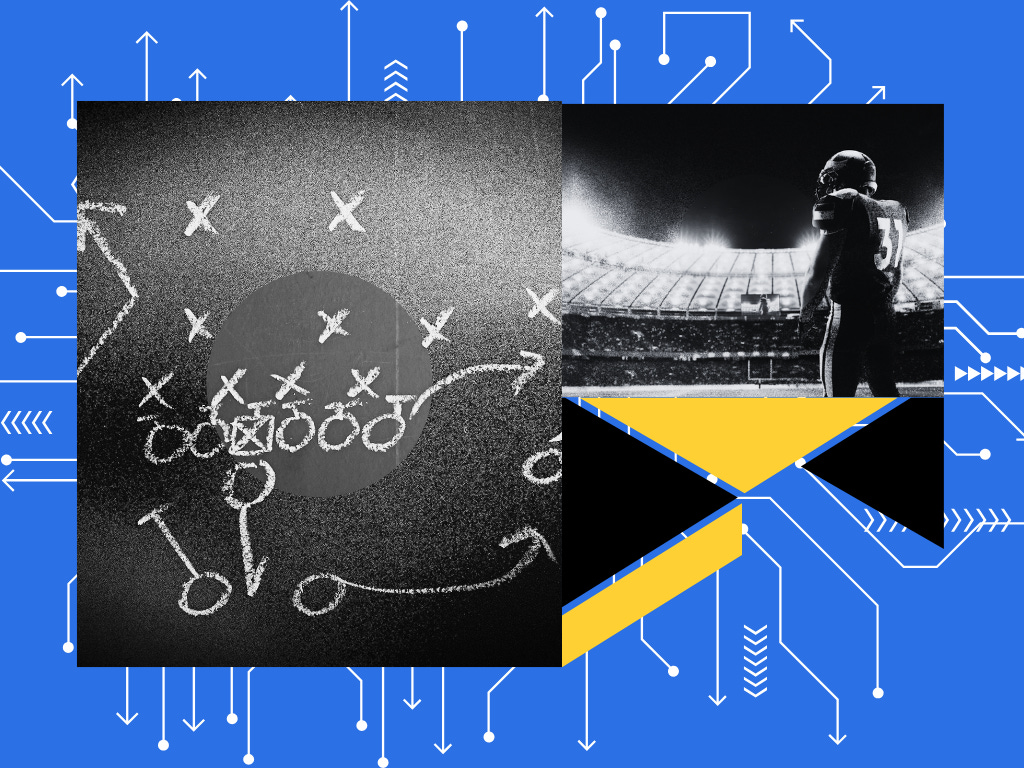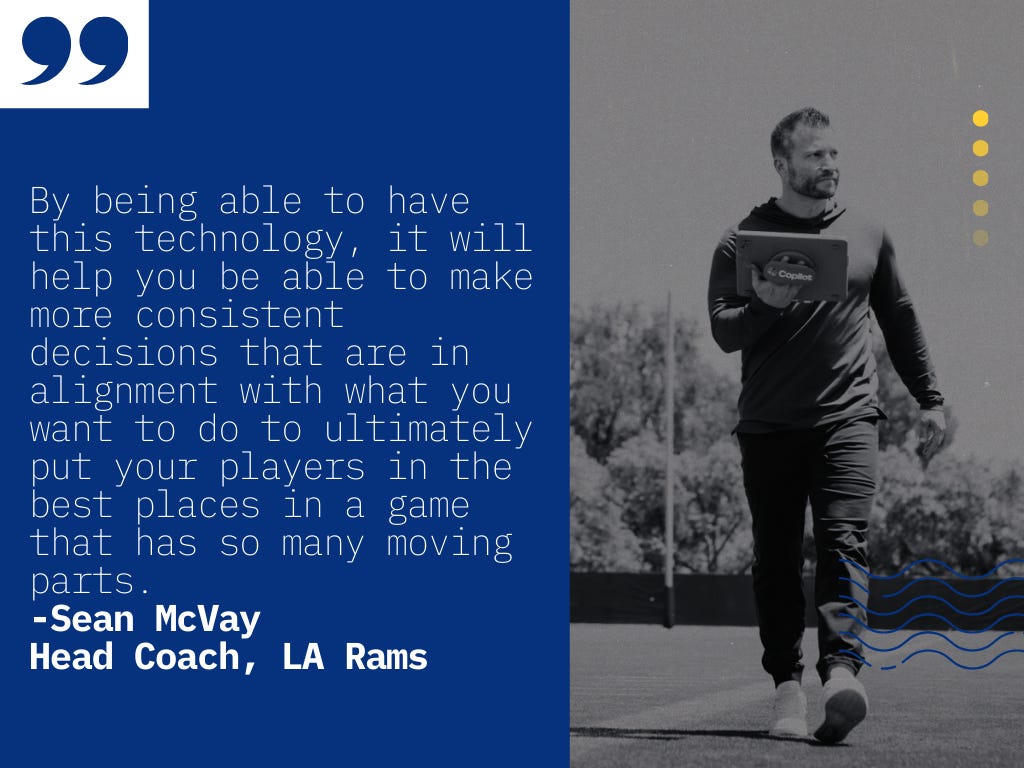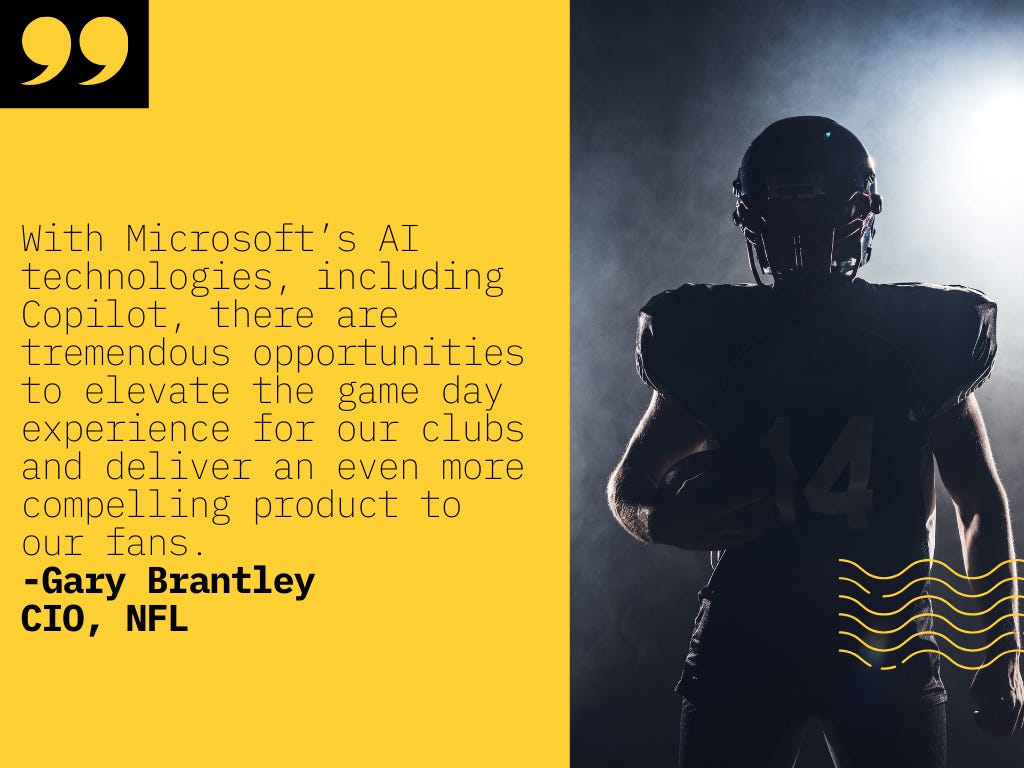The NFL’s Big AI Experiment
Microsoft’s Copilot partnership with the NFL is an inflection point for AI technology
In 2019, the first smartphones that featured 5G cellular technology debuted with the release of the Samsung Galaxy S10 5G. This moment started the 5G hype machine, with tech executives talking about the game-changing nature of the new technology. It was going to change the way we work, transform transportation, and usher in the future of computing. Most of this didn't happen. Instead, we got faster download speeds on our phones, and the 5G home internet market debuted.
5G was a moment where the tech world was trying to drive interest in something by envisioning the future. After the technology settled into a useful connectivity tool, the focus product of the future changed. The new darling of the tech world is AI. In the last 24 months, we have seen every company position new AI tools and tell us how it will "change everything"—from workflows to the way we consume entertainment.
For this to be successful, AI companies have to execute on their promises and show the utility as opposed to simply the promise of it. A company with a lot riding on the AI wave is Microsoft. The tech giant has invested over $80 billion in AI data centers and continues to tie its long-term growth to the success of its AI tools.
This goes beyond consumer applications of its Copilot chatbot, but extends to how it can leverage AI to deliver value to a wide range of clients. One of these clients is the NFL, which recently announced that it will be extending its relationship with Microsoft and bringing Copilot and AI solutions to the sideline to enhance the game of football. Football presents an interesting avenue for AI growth, and if this venture is successful, it may change the way teams look at data moving forward.
The Equation of Football
The continued partnership between the league and Microsoft starts with the NFL's Sideline Viewing System, which has been upgraded with more than 2,500 Microsoft Surface Copilot+ PCs to provide coaches, players, and staff with real-time data analysis tools. Because Copilot+ PCs feature dedicated AI hardware, teams are able to analyze plays and data quicker than before to make faster decisions.
The thought process here is that by utilizing AI tools, teams can learn more about what is happening in real time to make adjustments. For example, if a receiver is getting more separation on routes in the slot as opposed to aligning on the outside in the X and Z positions, then this data could lead to an adjustment to utilize that player more in the slot for maximum success.
The AI integration doesn't stop there. Microsoft's Azure AI video tools will be infused into practice sessions to facilitate the coaching process and make player evaluations simpler. The value proposition here is clear. Football is often a game of chance when it comes to selecting the right players for schemes, with many good players going undrafted. Enhanced video tools could help analyze who trends toward being a viable solution versus who is more of a long shot through specific data models.
The NFL is no stranger to incorporating technology in its operations. For many years now, coaches and players have relied on Microsoft's Surface devices to review replays and analyze where mistakes were made. Coaches have used communication devices to call out plays and adjustments to players in the huddle for decades now.
More recently, the league has also embraced deeper data with Next Gen Stats and Amazon Web Services being incorporated into broadcasts. These numbers go beyond simple yards and completions, but incorporate player speed, success rate, and improbable completions, among others. While other sports have incorporated this sort of data (shot distance in the NBA and home run length in MLB), it seems that the NFL has fully leaned into it because of the way the game is designed and the way that we understand it.
When you boil down the machismo and violence of the sport, football often becomes directional math. On any given play, there is a symphony of patterns and orchestration that can be looked at as a complex equation. On a simple running back dive play, for instance, the offensive linemen need to block in certain directions at the same time to create space for the runner. When executed properly, it becomes a positive play, but when it is not, it becomes a massive negative. Success rates of various formations and situations create an opportunity to optimize using a treasure trove of data.
The inclusion of AI allows for massive data processing, which enables coaches to filter plays of interest by quarter, play type, etc. This makes in-game decision-making dynamic and smarter—where coaches can see what plays have worked in certain situations and the types of tendencies that their opposition likes to call in those situations. This data has the potential to lead to smarter decision-making, but also has the potential to take away the idea of "gut calls" and general coaching intuition.
We have already seen this sort of analytics-based thinking influence the frequency of coaches attempting more fourth-down conversions in recent years. But the inclusion of Microsoft's AI tools through Copilot, Azure, and GitHub will accelerate this data usage, which has more practical application in a sport like football that is more reliant on choreography than spontaneity. With it comes enhanced efficiency, but does it also take the art away from the sport?
Art vs. Data
In 2018, Bleacher Report compiled a list of the 50 most exciting football players of all time. The top ten featured players like Gale Sayers, Michael Vick, Steve Young, Lawrence Taylor, Barry Sanders, and Randy Moss. These players have one thing in common: their greatness is defined outside the confines of positional expectations. Vick was an exceptional running quarterback in spite of the system that tried to turn him into a pocket passer, Sanders ran east and west when coaches screamed about running north and south, and Taylor made the football institution rethink how pass rushing should be done. These players disregarded conventional wisdom, and that is what made them great.
There is a viable question to be asked about whether more data will simply roboticize football and take the individuality out of players' hands. Will players be locked into roles and situations that the data speaks to and nothing else? That is the slippery slope that comes with relying solely on data versus marrying the data with football reasoning. We have seen this example play out in the NBA before when it comes to the analytics movement.
The Golden State Warriors were lauded as bringers of an analytics style with Steph Curry and Klay Thompson shooting a lot of three-pointers. This led to teams like the Houston Rockets emulating the style and only shooting threes and layups. They fell to the Warriors because the Warriors leveraged the data to better inform their scheme and took advantage of two all-time shooters on their roster. The Rockets just played the math and hoped that they would prevail—and they didn't, despite coming very close.
For football, there has to be a balance. This is not an alarming revelation for anyone who has utilized AI tools over the last few years. The slippery slope that has come with them is that they are being used not as tools but as do-it-all solutions. Part of this is due to the way that generative AI companies like OpenAI have marketed their chatbots. They have become effort replacements for many people, because marketing the ability to write an essay in mere seconds is much more exciting than a formula suggestion in a spreadsheet application.
There is growing anxiety about AI, which is why the technology is at such a pivotal point in 2025. With companies doubling and tripling down on AI, there are growing fears that it will compromise the job landscape. A Reuters poll showed that 71% of Americans fear that AI will permanently eliminate too many jobs. Coupled with the now well-documented environmental risks of AI, there are concerns about what the end use case for many AI solutions will be when the seemingly bottomless investment pit starts to dry up.
That's why a client like the NFL implementing an AI solution is pivotal to Microsoft and other AI-focused companies. They have the wow factor from their countless CEO promises, but the next step is to show true utility. To be able to say that they are enhancing the way that coaches and players approach football is a great way to do that. If this shift toward data is embraced by more coaches throughout the league, then we can't help but wonder how this will impact other sports as well.
The NFL is widely regarded as the leader in American sports by a healthy margin. If it becomes standard practice for their processes to involve heavy data analysis on a granular level, other sports will likely follow their lead. But is that what we want? Is efficiency at the expense of the unknown how we want to watch sports?
I would argue that the only path that makes sense is to use the data as a tool and not a north star. Using information and being beholden to it are two vastly different realities that are separated by an incredibly thin line. Should the Buffalo Bills avoid designed runs for Josh Allen just because the data says that their success rate is better when he takes a seven-step drop? Of course not. The improvements come at a more granular rate to marry the truth of the data with the intuition of football professionals.
The irony of it all is that the way that NFL teams will be using Copilot and other Microsoft AI services is the way that most consumers should be using it as well—as a supplementary tool and not an all-seeing divine source of truth. Generative AI is at an inflection point, where the investment needs to have a payoff. And the way that happens is through practical applications that visibly address specific needs and use cases.
If successful, the NFL can be shown as a hallmark of the way that AI is indeed the future that was promised and not the vaporware it can sometimes appear to be. The results would be both on the field and off—defined by enhanced play success and reduced player strain and injury through data analysis. This is a pivotal moment for the NFL, but an even more crucial one for AI—time will tell if it can have its moment or if it will recede into the bin of interesting ideas.







